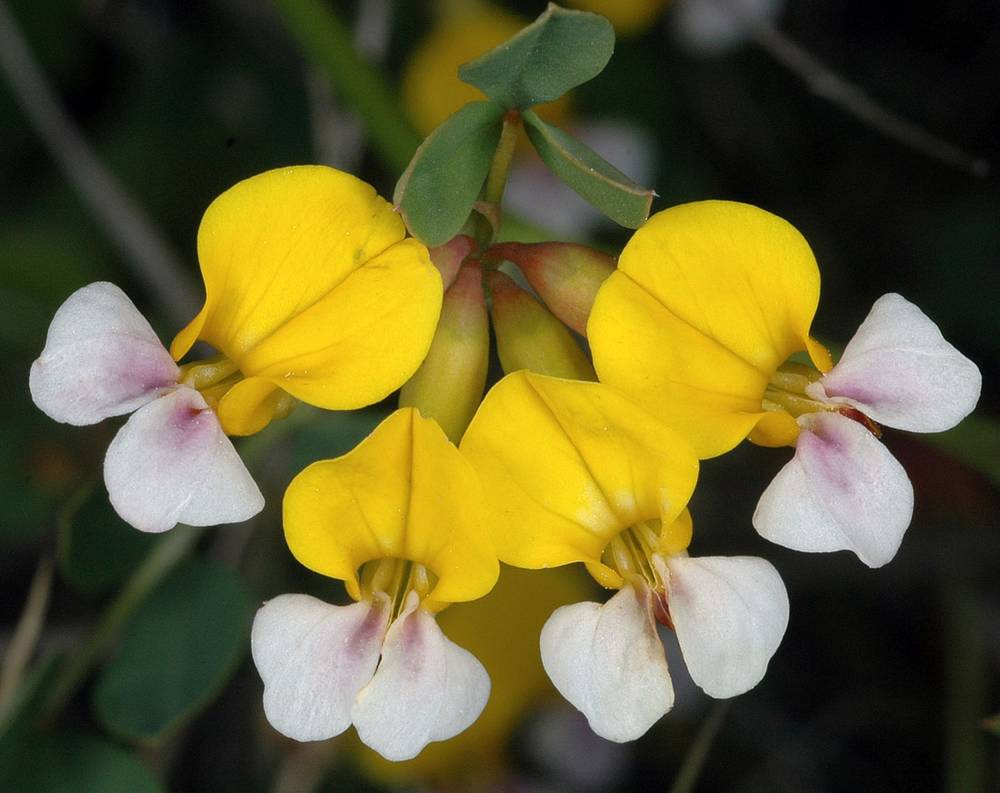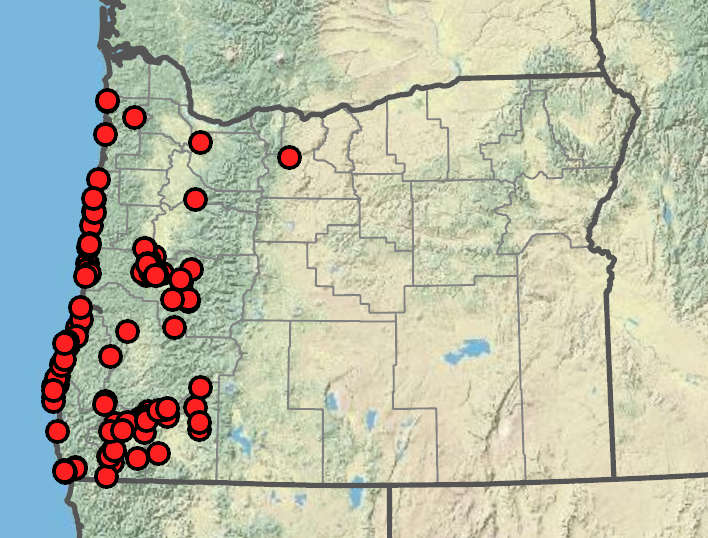Hosackia pinnata
Hosackia gracilis
bog deervetch
seaside lotus
1–10+, ascending or decumbent, often fistulose, occasionally branched near bases, distally usually with few or more numerous closely appressed, flattened trichomes.
1–20+, prostrate or decumbent to ascending; slender, sometimes sparsely branched, distally usually with scattered or numerous closely appressed, flattened trichomes.
2–11 cm;
leaflets 5–9, elliptic to obovate or oblanceolate, sometimes oval, 8–39 × 3–16 mm;
margins eciliate or ciliate;
tips emarginate or rounded to obtuse or acute;
surfaces glabrous or occasionally with minute trichomes appressed to abaxial midribs; young leaflets sometimes heavily invested with minute flattened trichomes;
petiolules 0.6–1.2 mm.
1–6 cm;
leaflets 3–7, elliptic or oblanceolate to obovate, 3.5–19 × 1.5–9 mm;
margins eciliate or rarely sparsely ciliate;
tips obtuse to emarginate;
surfaces glabrous;
petiolules 0.3–1 mm.
3–10(11)-flowered, with flowers on one side or occasionally ± radially disposed;
pedicels 0.5–1.5 mm.
2–5(6)-flowered, with flowers ± on one side;
pedicels 0.5–1.5 mm.
ascending, 2–17 cm, usually much ? subtending leaf; much elongating in fruit, often bearing a few scattered or sometimes copious closely appressed trichomes;
bracts directly subtending umbels; simple, generally scale-like, scarious, rarely leaf-like, 2–3(4) mm, sometimes absent.
spreading to ascending or erect, 1.5–8 cm, often much > subtending leaf, elongating in fruit, often bearing a few scattered or sometimes copious closely appressed, flattened trichomes;
bracts directly subtending umbel; leaf-like, 1–3(5)-foliolate.
slightly nodding; (12)13–16 mm;
calyces 6–8 mm, green or reddish, glabrous;
tubes obconic-cylindric, 4–5 mm;
lobes subulate to triangular, 1–3 mm, eciliate or sometimes sparsely ciliate; posterior pair of lobes and anterior 3 dissimilar in size; shape; and spacing;
corollas broad; showy;
claws conspicuously > calyx tubes;
banners large and spreading, yellow to yellow-orange, sometimes with reddish blush or reddish veins;
wings spreading widely, proximally pale yellowish, distally white, sometimes slightly pink; inner margins ± approximate, sometimes overlapping;
keels up to 3 mm < wings, bright yellow throughout or proximally paler with brighter yellow tips.
10–14(15) mm;
calyces 4.5–6.5 mm, green, often reddish or with reddish highlights, glabrous;
tubes obconic-cylindric, 2.5–4 mm;
lobes subulate to narrowly triangular, 1.5–2.5 mm, sparsely ciliolate or eciliolate; posterior pair of lobes and anterior 3 dissimilar in size; shape; and spacing;
corollas broad; showy;
claws conspicuously > calyx tubes;
banners large and spreading, yellow to sometimes yellow-orange or red-orange;
wings spreading widely, pale pink to lavender or deep red-violet; inner margins sub-approximate to commonly overlapping;
keels proximally yellow;
tips purple; ~1.5–2 mm < wings.
± inclined to declined; ± linear, 30–70 × 1.5–3 mm, dark brown to reddish.
inclined to declined, linear, 20–40 × 1.5–2.5(3) mm, brown, glabrous.
few, oblong, 2–2.7 × 1–1.5 mm.
usually 10–14, subreniform, nearly round in outline, 1–1.5 mm; olive to brown.
narrow, deltoid or ovate to ovate-lanceolate, 2.5–5 × 1.7–4; ± symmetric, scarious;
margins entire;
tips usually obtuse or acute.
narrow, deltoid or ovate to lanceolate, 2–6 × 1–3 mm; ± symmetric, scarious;
margins entire or occasionally toothed;
tips acute or acuminate, sometimes bifid.
=14.
=14.
Hosackia pinnata
Hosackia gracilis
Wetlands, meadows, stream margins, bogs. Flowering Apr–Jul. 0–1200 m. Casc, CR, ECas, Sisk, WV. CA, ID, WA; north to British Columbia. Native.
The similarity of H. pinnata to H. gracilis and their possible confusion is discussed under the latter species. The two species share an unusual type of minute trichome not seen among the other Oregon species of the genus. These trichomes (0.2–0.5 mm), which may be found on distal portions of stems and peduncles and on unexpanded leaflets, are strongly appressed, completely flat, and pointed at both ends.
Coastal bluffs and dunes, bogs, grasslands, grassy glades. Flowering Apr–Aug. 0–700 m. Est, Sisk, WV. CA, WA; north to British Columbia. Native.
Hosackia gracilis is primarily a coastal species that is most similar to the inland species, H. pinnata. Plants from a few inland populations, especially in Lane County, seem to be somewhat intermediate and may be difficult to place based on corolla color patterns alone. This treatment emphasizes the nature of the peduncle bract in determining the taxonomic placement of questionable material of these two species.
Gerald Carr
Gerald Carr
- Local floras:
BC,
CA,
OR,
WA
- Local Web sites:
CalFlora,
CalPhotos,
Flora NW,
PNW Herbaria
WildflowerSearch
iNaturalist (observations)
USDA Plants Database
- LBJ Wildflower Center
- SEINet
- Plants of the World Online
- Encyclopedia of Life
- Wikipedia
- Google Image Search
- Local floras:
BC,
CA,
OR,
WA
- Local Web sites:
CalFlora,
CalPhotos,
Flora NW,
PNW Herbaria
WildflowerSearch
iNaturalist (observations)
USDA Plants Database
- LBJ Wildflower Center
- SEINet
- Plants of the World Online
- Encyclopedia of Life
- Wikipedia
- Google Image Search





